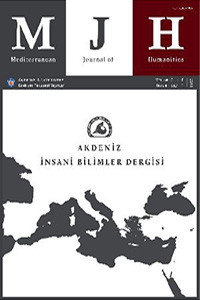Abstract
Literatürde sıkça ele edilen bulgularından birisi, kültürel aktivitelere katılımın eşitsiz biçimde gerçek-leştiği yönündedir. Kültürel tüketimi belirleyen ana unsurun kültürel sermaye olduğu, gelir ve toplumsal cinsiyet gibi değişkenlerin onu etkilediği nicedir bilinmektedir. Ancak kuşakların ve yaşın kültürel eşitsiz-lik mekanizmalarını nasıl etkilediğine ilişkin bulgular sınırlıdır. Bu çalışmada, Antalya Yaşlılık Araştır-ması’nın (AYA) veri seti kullanılarak kültüre düşkünlüğün örüntüsünü belirleyen ana unsurlardan birisi olarak kuşak etkileri analiz edilmektedir. Bulgular, sınıf ve toplumsal cinsiyetin yanında kuşaklar ara-sında da kültüre düşkünlüğün düzeyinin ve ritminin çeşitlilik gösterdiğini ortaya koymaktadır. Kültüre düşkünlüğün bu niteliği, kültürel eşitsizliğin şiddetinin de kuşaklar arasında ne denli geniş ve etkin oldu-ğunu yansıtır.
References
- Arun Ö. & Elmas Ç. (2016). “Yaşlılıkta Ayrım: Çağdaş Türkiye’de Yerel Yönetimleri Bekleyen Zorluklar”. Sosyoloji Dergisi 36/2 (2016) 351-372. DOI: 10.16917/iusosyoloji.291221
- Arun Ö. (2012). “Cultivated Citizens? Cultural Capital, Class, Gender and Generations in Contemporary Turkey”. METU Studies in Development 39/3 (2012) 283-302.
- Arun Ö. (2013). “Ageing in Turkey: The Peter Pan Syndrome?”. Eds. J. Troisi & H. J. von Kondratowitz, Ageing in the Mediterranean (2013) 297-324. London, UK.
- Arun Ö. (2014a). “İnce Zevkler – Olağan Beğeniler: Çağdaş Türkiye’de Kültürel Eşitsizliğin Yansıma-ları”. Cogito 76 (2014) 167-191.
- Arun Ö. (2014b). “Disability in Turkey: The Risks in Being Disabled for Accessing Educational Opportunities”. Mediterranean Journal of Humanities 4/1 (2014) 53-62.
- Arun Ö. (2015). “Kültürel Hepçiller: Ne Seçkin ne Sıradan, Sadece Olağan! Türkiye Televizyonunda İzleyici Beğenilerinin Analizi”. Toplum ve Bilim 133 (2015) 247-280.
- Bihagen E. & Katz-Gerro T. (2000). “Culture Consumption in Sweden: The Stability of Gender Differences”. Poetics 27 (2000) 327-349.
- Bourdieu P. & Darbel A. (2011). Sanat Sevdası: Avrupa Sanat Müzeleri ve Ziyaretçi Kitlesi. Ankara 2011.
- Bourdieu P. (1984) Distinction: A Social Critique of the Judgement of Taste. Cambridge 1984.
- Bryson B. (1996). “Anything But Heavy Metal: Symbolic Exclusion and Musical Dislikes”. American Sociological Review 61 (1996) 884-899.
- Budak Ö. (2014). “Esnek İstihdam Toplumunda Kültürel Sermaye”. Cogito 76 (2014) 152-166.
- Çelik Ç. (2014). “Sosyal Sermaye, Ebeveyn Ağları ve Okul Başarısı”. Cogito 76 (2014) 265-289.
- Chan T. W. & Goldthorpe J. H. (2005). “The Social Stratification of Theatre, Dance and Cinema Attendance”. Cultural Trends 14 (2005) 193-212. Christin A. (2012). “Gender and Highbrow Cultural Participation in the United States”. Poetics 40 (2012) 423-443.
- DiMaggio P. & Mukhtar T. (2004). “Arts Participation as Cultural Capital in the United States, 1982–2002: Signs of Decline?”. Poetics 32 (2004) 169-194.
- DiMaggio P. & Useem M. (1978). “Social Class and Arts Consumption. Origins and Consequences of Class-Differences in Exposure to Arts in America”. Theory and Society 5 (1978) 141-161.
- DiMaggio P. (1982). “Cultural Capital and School Success: The Impact of Status Culture Participation on the Grades of U.S. High School Students”. American Sociological Review 47 (1982) 189-210.
- Erickson B. H. (1996). “Culture, Class, and Connections”. American Journal of Sociology 102 (1996) 217-251.
- Friedman S., Savage M., Hanquinet L. & Miles A. (2015). “Cultural Sociology and New Forms of distinction”. Poetics 53 (2015) 1-8.
- Karademir-Hazır I. (2014). “Bourdieu Sonrası Yeni Eşitsizlik Gündemleri: Kültürel Sınıf Analizi, Beğeni ve Kimlik”. Cogito 76 (2014) 230-264.
- Katz-Gerro T. (1999). “Cultural Consumption and Social Stratification: Leisure Activities, Musical Tastes, and Social Location”. Sociological Perspectives 42/4 (1999) 627-646.
- Katz-Gerro T. (2002). “Highbrow Cultural Consumption and Class Distinction in Italy, Israel, West Germany, Sweden and the United States”. Social Forces 81 (2002) 207-229.
- Kraaykamp G., van Gils W. & Ultee W. (2008). “Cultural Participation and Time Restrictions Explaining the Frequency of Individual and Joint Cultural Visits”. Poetics 36 (2008) 316-332.
- Mohr J. & DiMaggio P. (1995). “The Intergenerational Transmission of Cultural Capital”. Research in Social Stratification and Mobility 14 (1995) 167-199.
Details
| Primary Language | Turkish |
|---|---|
| Subjects | Sociology of Aging |
| Journal Section | Research Article |
| Authors | |
| Publication Date | June 30, 2017 |
| Published in Issue | Year 2017 Volume: 7 Issue: 1 |

